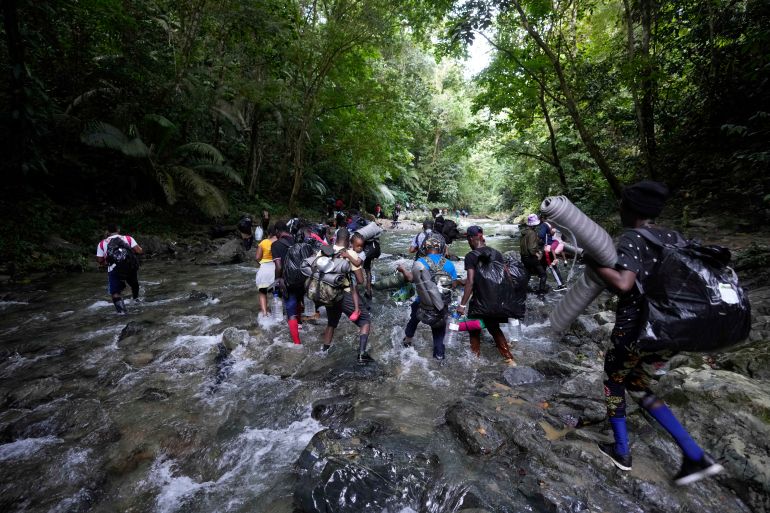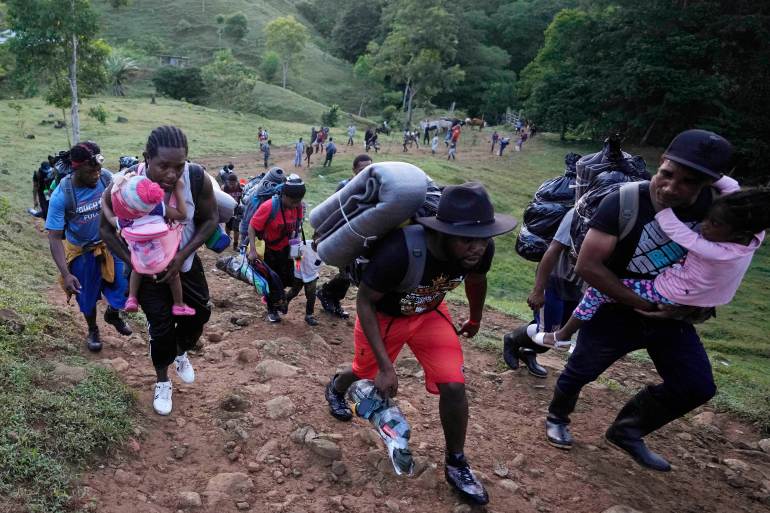The asylum seekers using TikTok to share perils of Darien Gap
Migrants say videos fill gap in knowledge about dangerous jungle passage, but experts raise concern over misinformation.

Bogota, Colombia – Before Enderson Contreras embarked on a 45-day journey that began in Peru and ended in the United States, he checked the popular video app TikTok for insights on the dangerous trek that lay before him.
Contreras had heard rumours of the dangers of the Darien Gap, a lawless, 96km (60-mile) jungle passage between Panama and Colombia that is known for its poisonous snakes and treacherous trails, as well as paramilitary factions and thieves.
Keep reading
list of 3 itemsDarien Gap: A Migrant Journey
Why are migrants risking it all to cross the deadly Darien Gap?
But what he found online was disappointing. “The videos that I watched at the time lacked information,” Contreras, a 25-year-old from Venezuela, told Al Jazeera. “That’s why I decided to make something to show what it’s really like to cross the Darien.”
Activists and researchers say social media sites and messaging platform WhatsApp have become top resources for refugees, migrants and asylum seekers as they plan their trips north towards the US. Those voyages have grown increasingly complex as countries put in place more restrictions, and refugees and migrants are forced to take more informal routes.

With passage through the Darien Gap more common — approximately 134,000 people crossed last year alone – firsthand accounts of the jungle, uploaded on TikTok, have received thousands, and in some cases, millions of views. As of September, the hashtag #darien had been viewed close to half a billion times.
“These videos have gone viral because people feel the need to know how viable it is to flee,” said Jonathan Noguera, a refugee and migrant rights activist in Lima, Peru.
Record numbers of crossings
As of September, the number of refugees and migrants travelling through the Darien Gap this year reached more than 134,000, according to Panamanian migration authorities, surpassing the 133,726 that crossed for all of 2021.
While neither Panama nor Colombia has published official figures on the refugee and migrant death toll, local news outlets reported that at least 76 people had died on the trail as of July. Many of those crossing are from Venezuela, where widespread food insecurity, violence and poverty have pushed nearly 7 million people to flee in the last years.
But with state presence minimal across the jungle pass, information on the Darien Gap is scarce, whereas refugee and migrant-shot videos are numerous and easily accessible.
@endercontrerass
Contreras, who now lives in southern Florida, uploaded more than half a dozen videos to TikTok of his trek across the Darien Gap that together have garnered more than 12 million views. They show streams of refugees and migrants struggling up steep slopes, families huddling around rivers to rest, and travellers treading cautiously on muddy trails.
In a viral video posted by another TikTok user, a sturdy rope is needed to help a group of about 25 cross a rushing river. In another video with 4.1 million views, a man is unable to walk after sustaining a leg injury. The creator of the video calls his family members to get in touch and later says in a follow-up video that the man died of a heart attack on the trail.
While it is impossible to say whether the viewers are mostly refugees and migrants, experts told Al Jazeera that the videos point to a lack of human rights protections for those who make the dangerous journey across the Darien Gap.
Maria Clara Robayo, a migration researcher at the Venezuela Observatory at Bogota’s Rosario University, said the videos also present a new concern: misinformation.
“The great risk is that no one is controlling this information. No one knows who is publishing the videos or what their interests are,” she told Al Jazeera.
“While it’s important that these videos on TikTok and other social media platforms are emerging, public policies that coordinate this information are needed. So are official sources that provide a counterweight to this information.”
@innaramirez3 Muy duro, pero no imposible. #adios #emigrar #eeuu #selvadeldarien #venezolana #viaje #siguemeeeeeeeéeeeéseeeeeeeeeeeeeeeeee #fyppppppppppppppppppppppp
‘Every day, I prayed’
Authorities from Colombia and Panama have yet to publicly comment on the growing popularity of refugee and migrant TikTok videos or on concerns around misinformation being spread on the platform. A Colombian migration official told Al Jazeera he was not familiar with the videos.
But the Darien Gap crossings do not appear to be slowing down, especially as economies in South and Central America continue to struggle amid soaring inflation, and xenophobia rises in regional countries that are hosting refugees and migrants.
While Venezuelan refugees and migrants previously flew into Mexico before trying to reach the US border, a new visa requirement in Mexico — as well as in other Central American countries — has forced many to travel through the Darien Gap.
David Ramirez, 25, spoke to acquaintances and did research online before leaving in early August for the jungle passage from his home in the Venezuelan city of Barcelona, a former tourism hotspot east of the capital, Caracas.
After a quick look through YouTube, Ramirez said he ended up on TikTok, where he found a wealth of videos. “I saw recordings of people who had died, of the mountains, the animals. I watched everything I could,” Ramirez told Al Jazeera from New York City, where he is currently staying at a shelter and preparing to apply for political asylum.
Ramirez said the accounts frightened him, but they did not dissuade him from making the journey; instead, they helped him identify what he would need to survive, such as sturdy boots and clothing, rope, and a disinfectant used to fend off wild animals.
“I brought a lot of these things that I saw in the videos, and they were useful,” said Ramirez, who hiked for seven days under heavy rain before emerging from the jungle.
For his part, Contreras said that while some of the videos he posted on TikTok show him laughing with family members that made the journey alongside him, those moments do not negate the difficulties of crossing the Darien Gap.
“Some people get confused. They say, ‘How hard can it be if you were laughing or having fun?’” said Contreras. “I didn’t make any videos crying, but I cried,” he continued. “Every day, I prayed: ‘God, please get us out of here.’”